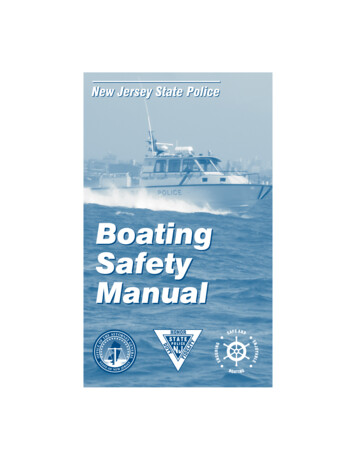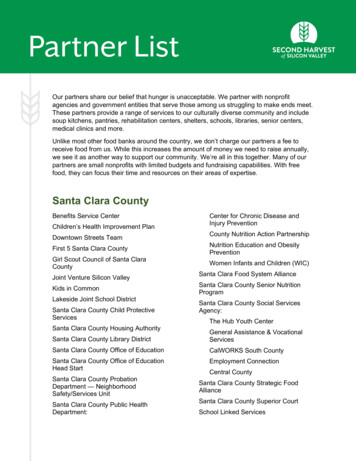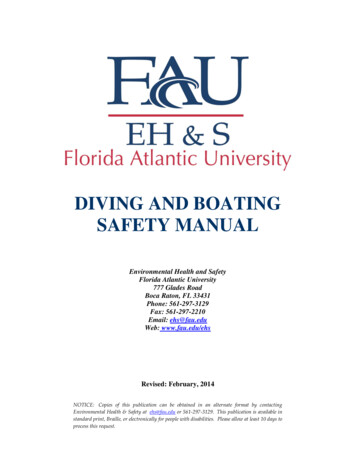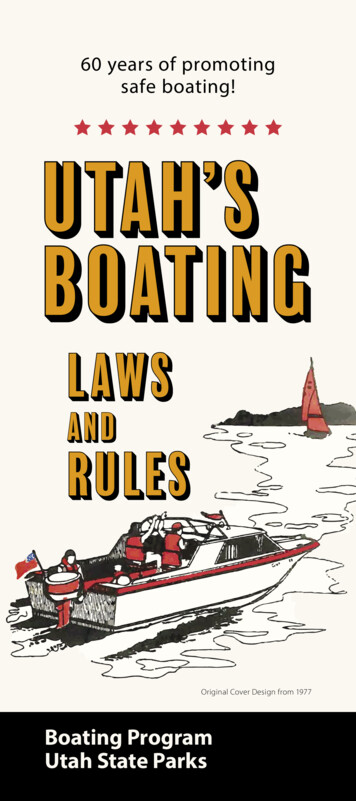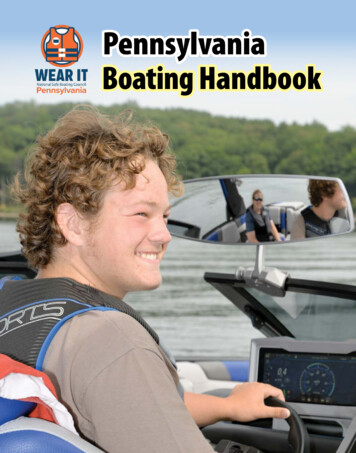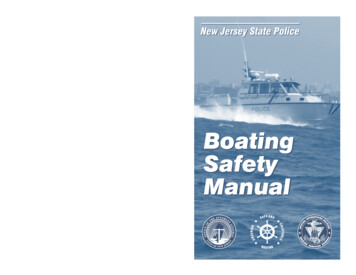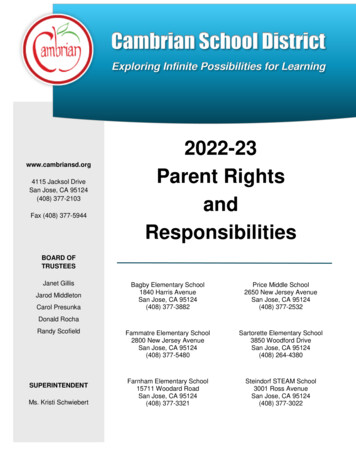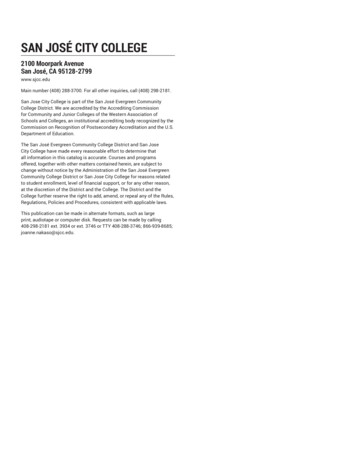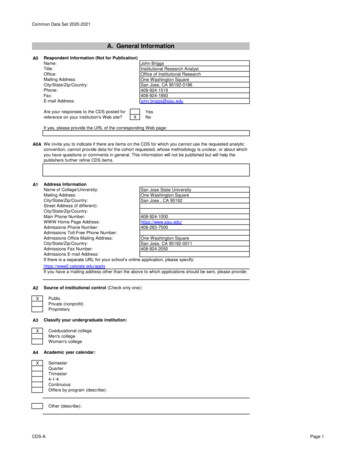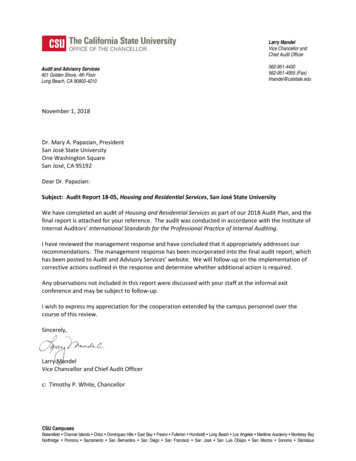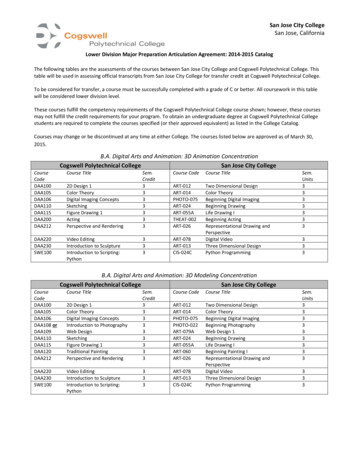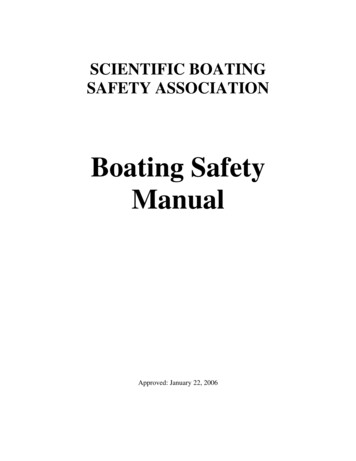
Transcription
SCIENTIFIC BOATINGSAFETY ASSOCIATIONBoating SafetyManualApproved: January 22, 2006
TABLE OF CONTENTSSectionPage1.00OVERVIEW . 11.10PURPOSE. 11.20CONTENTS. 11.30APPLICABILITY. 12.00RESPONSIBILITY. 22.10BOATING SAFETY COMMITTEE MEMBERSHIP. 22.20BOATING SAFETY COMMITTEE RESPONSIBILITY. 22.30BOATING SAFETY OFFICER . 22.40PRINCIPAL INVESTIGATORS . 32.50BOAT OPERATOR . 33.00ADMINISTRATIVE PROCEDURES & TRAINING REQUIREMENTS . 43.10AUTHORIZATION OF BOAT OPERATORS . 43.20MAINTAINING AUTHORIZATION . 43.30REVOCATION OF AUTHORIZATION. 43.40RE-AUTHORIZATION . 43.50TRAILERING . 43.60LAUNCHING AND RETRIEVING . 44.00ADMINISTRATIVE PROCEDURES & RECORD KEEPING . 54.10FLOAT PLANS. 54.20MAINTENANCE OF RECORDS. 54.30ACCIDENT REPORTING. 55.00OPERATIONAL PROCEDURES. 55.10STABILITY. 55.20EQUIPMENT . 55.30COMMUNICATIONS . 65.40WEATHER. 65.50SPECIAL OPERATIONS . 65.60SAFETY CHECKS. 6SUGGESTED APPENDICES - (OMs should provide their own appendices123456Safety Equipment. . 7Float Plan. . . 8Boating Project Approval Form. . .9Boating Emergency Management Procedures. . .10Boating Accident Report Form. . 11Sample Individual Underway Hours Log. .127Glossary .13
SCIENTIFIC BOATING SAFETY ASSOCIATIONBOATING SAFETY MANUALSECTION 1.00OVERVIEW1.10PURPOSEThe purpose of these boating standards is to ensure that all boating is conducted in a manner thatwill maximize safety and to set forth standards for training and certification that will allow aworking reciprocity between organizational members.1.20CONTENTSThe Scientific Boating Safety Association (SBSA) Boating Manual establishes minimumguidelines for the operation of all non-UNOLS boats by Organization Members (OM).The Organizational Members’ SBSA Boat Manual shall include:1.301Policy that pertains to all vessels operating under the auspices of the OM.2Guidelines for obtaining and maintaining boat operator authorization.3Administrative procedures.4Equipment standards.APPLICABILITYThe provisions of this manual apply whenever OM personnel are using a boat under OMauspices, regardless of ownership of the boat.Specific examples of boat operations under OM auspices include: persons engaged in research,earning academic credit, employees acting within the scope of their employment; studentsengaged in any research operation including those receiving or providing boat operationinstruction or involved in boat checkouts.Boats used under OM auspices include:1Boats owned, supported, or administered by the OM, regardless of ownership.2Privately owned boats used by the OM for scientific or educational purposes.3Any other vessels used by the OM for scientific or educational purposes.4In case of joint operations, the lead institution will ensure that all applicable safetystandards are being met.1
SECTION 2.00RESPONSIBILITY2.10BOATING SAFETY COMMITTEE MEMBERSHIPBoat Safety Committee membership should consist of:2.202.301.Chief Administrative OfficerThe CAO has the ultimate responsibility for the boat program and its related activities2.Other MembersShould consist of a majority of persons who are knowledgeable about boatingoperations3.Boat Safety Officer (BSO), [or OM equivalent]BOATING SAFETY COMMITTEE RESPONSIBILITY1Has autonomous and absolute authority over the boating program’s operation.2Shall review and revise the boating safety manual.3Shall assure compliance with the boating safety manual.4Shall take disciplinary action for unsafe practices, and act as a board of appeal.5Shall recommend the issue, reissue, or the revocation of boating authorizations.6Shall establish and/or approve training programs through which the applicant can satisfythe requirements of the organizational member’s boating safety manual.7Shall suspend boating operations that are considered to be unsafe or unwise.8Shall periodically review the Boating Safety Officer’s performance and program.9Shall sit as a board of investigation to inquire into the nature and cause of boatingaccidents or violations of the organizational member’s boating safety manual.10May grant exceptions to this manual.BOATING SAFETY OFFICER (BSO)The Boating Safety Officer (BSO) serves as a member of the Boating Safety Committee (BSC).This person should have broad experience in boating.Duties and Responsibilities1Shall be responsible, through the BSC, to the responsible administrative officer ordesignee, for the conduct of the boating program of the membership organization. Theroutine operational authority for this program, including the conduct of training andauthorization, and ensuring compliance with this standard and all relevant regulations ofthe membership organization, rests with the Boating Safety Officer.2May permit portions of this program to be carried out by a qualified delegate(s), althoughthe Boating Safety Officer may not delegate responsibility for the safe conduct of the OMboating program.3Shall suspend boating operations considered to be unsafe or unwise.2
2.402.50PRINCIPAL INVESTIGATORS AND ADMINISTRATIVE OFFICERS1Principal Investigators and Administrative Officers are responsible for assuring that allboat operations that are part of a program under their direction are conducted inaccordance with this manual.2Principal Investigators and Administrative Officers must determine that all individualsassigned to boat operations related to their projects are properly authorized as describedin section 3.10 of this manual.BOAT OPERATOR1Only authorized OM boat operators may operate small boats under OM auspices, whetheror not the boat is owned by the OM. Exceptions may be granted by the BSO for vesselsrun by non-OM owner/operators.2In US waters non-OM owner/operators must comply with USCG, state, and localregulations covering chartered vessels. In foreign waters, the responsible OM personshall ensure the vessel meets the equipment requirements of this manual.3The designated boat operator is responsible for all aspects of boating operations,regardless of any senior personnel present in the boat. These responsibilities include, butare not limited to:a)Safety of the vessel and all persons on board.b)Operation of the vessel in compliance with federal, state, and local regulationsand this manual.c)Safe transport of the vessel to and from the launch site, if applicabled)The safe operation of all equipment.e)Ensuring that all required operational and safety equipment is on board and thatcrew and passengers know the location and how to operate safety/survivalequipment.f)Report all accidents, incidents, boardings, citations, safety concerns, and issues tothe BSO.4Failure to comply with provisions of the Boating Safety Manual may be cause for therevocation or restriction of the operator's authorization. However, any operator maydeviate from the requirements of this manual to the extent necessary to prevent orminimize a situation that is likely to cause death, serious physical harm, damage to thevessel, or major environmental damage.5The operator or person in charge of a vessel is obligated by law to provide emergencyassistance that can be safely provided to any individual in danger at sea. The operator orperson in charge is subject to a fine and/or imprisonment for failure to do so.3
SECTION 3.00ADMINISTRATIVE PROCEDURES AND TRAINING REQUIREMENTS3.10AUTHORIZATION OF BOAT OPERATORSBoat Operator AuthorizationTo become an authorized boat operator submit the OM’s application form and:1. Complete a boating safety course from a BSC approved provider.2. Provide documentation of, and/or acquire, practical experience in operating a boat.3. Demonstrate proficiency in the safe operation of the proposed type of boat in localconditions.4. Demonstrate proficiency in the operation of any specialty equipment and proceduresspecific to the boat.3.20MAINTAINING AUTHORIZATIONOM’s shall set standards for maintaining authorization. At a minimum operators shall be reauthorized every five years.3.30REVOCATION OF AUTHORIZATIONA boat operators’ authorization may be revoked for any action deemed unsafe or unlawful or fornot meeting the procedural requirements of the OM.3.40RE-AUTHORIZATIONIf a boat operator's authorization is revoked, they may be re-qualified after the operator complieswith such conditions as the Boating Safety Officer may impose. The operator shall be given theopportunity to present his/her case to the BSC before conditions for re-authorization arestipulated.3.50TRAILERINGTo become qualified to tow a boat and trailer, the operator or designated driver must demonstrateto the Boating Safety Officer or his/her designee the proper procedures for towing the boat andtrailer over the road, as well as launching and retrieving the boat from the trailer to the water. SeeAppendix # for guidelines.3.60LAUNCHING AND RETRIEVINGOM’s shall set forth guidelines for launching and retrieving as applicable.4
SECTION 4ADMINISTRATIVE PROCEDURES AND RECORD KEEPING4.10FLOAT PLAN – SEE APPENDIX 2All boat operators conducting boat operations under the auspices of the OM should file a floatplan with a responsible party prior to departure.4.204.30MAINTENANCE OF RECORDS1A file of usage for all boats, including a log of scheduled and unscheduled maintenancefor each boat and boat trailer shall be maintained.2Records shall be maintained for a period deemed appropriate by the OM.ACCIDENT AND INCIDENT REPORTING1All accidents must be reported to the Boating Safety Officer within 24 hours of theincident.2Incidents and near accidents, breakdowns or other unsafe events whether on land or at seamust be reported to the Boating Safety Officer within a time period specified by the OM.3Any accident causing loss of the vessel, damage over 2,000, requiring medical treatmentbeyond first aid, or loss of life must be reported to the U.S. Coast Guard.4The Boating Safety Committee shall investigate and document the accident as describedin 3 above and related personal injury and/or property damage and prepare a report.5Accident reports shall be held for five years.5
SECTION 5.00OPERATIONAL PROCEDURES All boats and equipment used by OM authorized operators in US waters, regardless of ownership,will, at a minimum, conform to U.S. Coast Guard, state, and local requirements and to thestandards set forth in this manual. All boats operated outside of U.S. Coast Guard jurisdiction shall at a minimum comply with U.S.Coast Guard regulations in addition to any applicable local requirements and to the standards setforth in this manual.5.10STABILITYNo person may operate a vessel loaded in a manner that will jeopardize the safety of the operatoror crew.5.205.30EQUIPMENT1The operator shall be familiar with the operation of the equipment and shall inspect allemergency equipment prior to departure.2The operator and/or crewmember shall notify the responsible person of anymalfunctioning equipment.3The nature of specific operations may require vessels and boating equipment to meethigher standards as determined by the Boating Safety Officer or the Boating SafetyCommittee.COMMUNICATIONSOM shall set minimum communication guidelines.5.40WEATHEROM shall establish weather guidelines for boating operations.5.50SPECIAL OPERATIONSOM shall establish guidelines for special operations such as; foreign waters, SCUBA diving,trawls, live boating, night operations, equipment deployment, etc.5.60SAFETY CHECKSPrior to Departure Boat Operator Shall:1.Perform a functional inspection of the boat and equipment, including communications.2.Assess all environmental conditions – weather, water conditions, etc.3.Give a briefing to all on board including, at a minimum, emergency procedures, locationof PFDs, fire extinguishers, man overboard, and methods of seeking assistance.After Returning1Upon return the operator will close the float plan as agreed upon before departure.2Notify within 24 hours, the responsible person, of any problems with the boat orequipment that occurred during the cruise.6
APPENDIX 1Safety EquipmentMotorboats operating in coastal waters shall carry at least the following equipment: One VHF radio or cell phone, whichever is more appropriate to the environment. Class I, II, III or V PFD for each person on board, plus one ‘throwable’ device. Signal flares - smoke flare(s) and - 3 day/night signaling devices. Fire extinguisher(s) will meet or exceed those required by law, and a fire extinguishing system onall motorboats with open spaces under decking. Fog horn, or other audible signaling device. Proper registration and documentation for the vessel. Each vessel shall meet federal, state, and local numbering requirements.Suggested equipment as appropriate for vessel & operations: Alternate method of communication Anchor and anchor line Oars or paddles Emergency repair kit and tools First aid kit and, if diving, an oxygen unit, rescue blanket, etc. Drinking water Spare fuel and oil, if needed Sea anchor Dock lines Bailer Boat hook Spare parts including prop, nut, etc. Suitable tool kitNavigational items – compass, GPS Back-up communications – slate, hand-held radio, cell phone Extra lines and tow harness Extra food rations Flags – dive and alpha Running and RAM lights as needed. Bilge pumps manual and electric if feasible EPIRB Spare key and deadman7
APPENDIX 2Float PlanAll vessels operating under the auspices of the OM must, at the minimum, be in compliance with local,state and USCG regulationsDate:Departure time:Estimated return:Name & description of vessel:# of people on boardNames:Contact #Area of operations. (be specific):Type of activity:Point of departure:Description of tow vehicle if applicableIf overdue, contact:Contact #Emergency plan, including activation time:Local information & emergency numbersEmergencyUSCG911Monitors VHF 168
APPENDIX 3Request for Scientific Boating Project Approval or Renewal1. Name of project:2. Name of Principal Investigator or Administrative Officer:3. Department:4. New or an ongoing project?5. Research project description and goals. Use a separate sheet if necessary:6.Vessel name & description:7. Vessel owner & Operator(s):8. Names & affiliation of those on board:9. Location of project:10. Dates of start and end of operations:11. Special conditions or logistical considerations:12. Emergency procedures (EMS activation, nearest medical aid, etc.):Other universities, institutions or groups involved with the projectFOR OFFICIAL USEProject # :Renew on:Signature, Chair BSCDate9
APPENDIX 4BOATING EMERGENCY MANAGEMENT PROCEDURESIntroductionMost boating incidents take place through the culmination of several factors leading up to a single pointwhen unsafe situations combine and pass a critical point resulting in an emergency situation. Identifyingthese factors and correcting them immediately is the best course of action.General Procedures (Personnel Injury)The nature and severity of personnel injury shall be the determining factor for the mode and method ofpatient transport.Make contact with victim, if safe, rescue as required.1. Establish ABC’s. (Airway, Breathing, Circulation) Then apply first aid as required.2. Determine severity and select the mode of transport. (Self transport, USCG, or EMS3. As applicable, contact the pre-designated land base, USCG channel 16 VHF, or EMS 911. Orlocal equivalent4. Coordinate with EMS for patient transfer site and ETA.5. Notify the Boating Safety Officer or the designated Assistant.6. Complete the Accident Forms as required.General Procedures (Non-urgent Disabled or Damaged Vessel)For non-emergency related damage or disabling situations it is the responsibility of the operator tosuspend the mission and assess all conditions then take appropriate action. The operator mustcommunicate the situation to the designated mother-ship or land-based point of contact. A communicationschedule shall be established to monitor the situation until safe moorage is obtained.1. Apply measures to minimize or correct the situation and contact land base or mother ship. Location Nature of problem Type of assistance needed Number of persons on board Establish a communication schedule based on severity.2. Arrange USCG assistance if another assistance provider (such as Vessel Assist) isnot available. Hail USCG on VHF Channel 16 and follow their directions. Same as #1 above. Request notification of the land base that is holding your float plan.2. Notify the Boating Safety Officer or the designated Assistant.3. Complete the Accident Form if required.Emergency Procedures (Collision, Fire, Flooding, Grounding, Crew overboard)Severe situations that can lead to the loss of life and property are collision, fire, flooding, grounding andcrew over board. Each of these situations requires the operator to immediately initiate measures to correctthe situation. Additionally, the USCG and/or another designated agency shall be notified to facilitaterescue and/or assistance.1. Initiate control measures to prevent/minimize loss of life and the vessel.2. Contact USCG Channel 16 VHF MAYDAY, MAYDAY, MAYDAY! Location (Speak slowly and repeat position) Nature of distress Vessel name, ID number & description Number of people on board3. Request notification of the Boating Safety Officer or the designated Assistant assoon as possible.
APPENDIX 5BOATING ACCIDENT REPORT FORMIn California seehttp://dbw.ca.gov/PDF/AccidentForms/BAR.pdf11
APPENDIX 6INDIVIDUAL UNDERWAY HOURS LOGIndividual Underway Hours LogName:Department:Month/Year:Signature: DateDateDay /NightGeneral Description ofMission Type ofOperations andCommentsArea orLocation(Inland/Offshore)Day /NightDay /NightDay /NightDay /NightDay /NightDay /NightDay /NightDay /NightDay /NightDay /NightDay /NightDay /NightDay /Night12VesselSizeVesselPropulsionType andNumberVessel LaunchMethodTotalTimeUnderway
APPENDIX 7GLOSSARYFrom CA Department of Boating & Waterways Boating AbaftToward the rear of the boat or vesselAboard On, in or into a boat.AbreastSide by side; by the side of.AftDescribing the after section of a vessel, or things to the rear of amidships and near thestern.AheadIn a forward direction.Aid to Navigation (ATON) Any device external to a vessel specifically intended to assist navigatorsin determining their positions or safe courses, or to warn them of dangers or obstructions.All-RoundA light which shows all the way Light around; 360 degrees.AmidshipsMidway between the bow and the stern on a boat.AnchorA forging or casting shaped to grip the sea bottom and, by means of a cable or rope, holda boat in a desired position.AnchorageA suitable place for anchoring in relation to the wind, seas and bottom.Anchor LineA line used to hold a vessel fast to the anchor.ArrhythmiaAn irregularity in the rhythm of the heart’s beating.AsphyxiationTo cause a loss of consciousness as a result of too little oxygen and too much carbondioxide in the blood; suffocation. Astern Behind or towards the rear of a vessel.AthwartAcross.Auxiliary EngineA “stand by” source of power.BBailTo remove water from a boat by pump or bailer.Bass BoatA modified skiff or jon boat. Usually has a covered forward deck and a powerful motor toget to fishing places quickly. Used on lakes and rivers.BathersSwimmers.BeamImaginary line amidships at right angles to keel of vessel. Also vessel’s width amidships.BearingThe direction of an object from an observer.BerthA bed or boat slip.BightThe part of the rope or line, between the end and the standing part, on which a knot isformed.BilgeThe lower internal part of a boat’s hull.Bilge Pump A submersible pump that is used to pump water out of the bilge.
Blind Bend An area in which another vessel may be obscured from view.BoatA waterborne craft smaller than a ship.BollardA fitting usually on a dock, pier or wharf to which mooring lines can be attached.BowThe forward part or front of the boat.BowlineThe name of a commonly used knot.Bow LineA docking line leading forward from a vessel’s bow.BuoyA floating aid to navigation.CCabinA compartment for passengers or crew.Can BuoyA green cylindrical buoy bearing an odd number and marking the port side of a channelfrom seaward.CanoeA lightweight, long, narrow boat propelled by a paddle or sail.CapacityGives maximum weight of Plate passengers and gear and permitted horse-power of themotor. Must be in full view of the operator’s station.CapsizeTo turn over.Carburetor Backfire Flame ArrestorRequired equipment on all motorboats except outboards anddiesels. Reduces chance of fire caused by sparks in internal combustion engines.Cast OffTo release all mooring lines.Catamaran Boat with two hulls connected by a deck.CenterboardA pivoting board or metal plate, housed in a slotted trunk, which can be raised orlowered. When lowered it reduces a sailboat’s leeway (tendency to sideslip).Chafing Gear Cloth, tape, or material attached around a line or rigging to prevent wear or chafing.ChannelThe part of a body of water deep enough for navigation through an area otherwise notsuitable; usually marked by ATONS or range markers.ChartA map of a body of water that contains piloting information.ChineThe intersection of the sides and bottom of a boat.CleatA piece of wood or metal with projecting ends to which lines are made fast.ClewThe lower, aft corner of a sail.Clove Hitch A hitch temporarily fastening a line to a spar, piling, or another line.ClosureThe act of closing the distance between two vessels.CompassThe instrument which shows the heading of a vessel.CouplerA device on the tongue of a trailer; attaches the trailer to the ball of the towing vehicle.CourseThe average heading and the horizontal direction in which a vessel is intended to be steered.CowlHooded opening that provides ventilation.CrossingThe situation in which one vessel Situation moves across the path of another.CruiserA seaworthy craft that usually has some sort of living quarters.
Cuddy Cabin A small shelter cabin.CurrentThe movement of the water in a horizontal direction.DDanforthDangerA patented lightweight anchor Anchor characterized by long, narrow twin flukes, pivotedat one end of the relatively long shank.A series of five or more short blasts Signal on a vessel’s whistle, air horn, or other signalingdevice.Danger Zone The area of a vessel from dead ahead to 22.5 degrees abaft its starboard and port beams.Daybeacon An ATON consisting of one or more daymarks and the piling to which they are attached.DaymarkA signboard shaped like a diamond, square, triangle or octagon.DeckAny permanent covering over a compartment.DinghyA small rowboat.Distress Signal : See Visual Distress Signal. 1. Mayday, Mayday, Mayday. Also 2. Any of a number ofdevices for showing a vessel needs help.DiureticDrug or substance that increases the output of urine causing dehydration. Caffeine in coffeeor soft drinks is an example.Diving Flag The white-and-blue, swallow-tail, Alpha signal flag, or a red flag with a white diagonalstripe used to indicate a diver in the area.DockA place to moor a vessel; the act of mooring a vessel to a pier or wharf.Documented VesselA vessel registered with the U.S. Coast Guard.DraftThe depth of a vessel’s keel and propeller below the waterline.DryThe material in some Class B fire Chemical extinguishers; baking soda.EEddyA current that moves in the opposite direction of the main current.EPIRB (Emergency Position Indicating Radio Beacon) An automatic radio transmitter that should becarried on any boat that is operating off shore. When activated, it sends a signal that there isan emergency and guides searchers to the position.Exposed waterIs defined as that subject to severe winds and waves. It includes marine, coastal,estuarine, and lake environments where severe winds and waves are probable.Eskimo Roll The primary self-rescue technique for kayakers to right themselves after capsizing. Thepaddler remains sealed in the kayak while performing a series of steps that brings themupright.
FFairwayA navigable part of a river or bay through which vessels enter or depart; a part of a harboror channel that is kept open and unobstructed.Federally Navigable Waters The seas and waters which provide a “road” for transportation betweentwo or more states or to the sea.FendersObjects placed along the side of the boat to protect the hull from damage.FerryWhen referring to river travel, a method used to navigate across a river current with little orno downstream travel.Figure Eight KnotA knot in the form of a figure eight placed in the end of a line to prevent the linefrom passing through a grommet or a block.FishtailThe side-to-side motion of a trailer when it does not have sufficient weight on its tongue.Flame ArrestorA safety device on an inboard or stern drive engine which prevents anexplosion from an exhaust backfire.Flare1. The outward spread of the boat’s sides from the waterline to the rail at the bow. 2. Avisual distress signaling device.Float PlanA document that describes the route(s) and estimated time of arrival of a particular voyage.It usually includes a description of the vessel, its equipment, and its passengers.ForwardToward the bow.FouledAny piece of equipment that is jammed or entangled, or dirtied.Four-Pole Connector An electrical connector commonly Electrical used to connect a tow vehicle and atrailer. Comes in two different and incompatible shapes, flat and round.FreeboardThe vertical distance measured on a boat’s side from the waterline to the gunwale.GGearA general term for ropes, blocks, tackle and other equipment.Give-Way VesselRequired to take early and obvious action to avoid a collision when nearinganother vessel. Does not have the right-of-way.Grab Rails Hand-hold fittings mounted on cabin tops and sides for personal safety when movingaround the boat.GPSShort for Global Positioning System. This is a satellite system used for highly accuratenavigation and pin-pointing of location.GrapnelA straight-shank anchor with four or five curved claw-like arms and no stock.GunwaleThe upper edge of a boat’s side. (Pronounced gun-nel.)HHailing Port A port to which a boat is documented with the U.S. Coast Guard.Hard-Chined Hull shaped with flat panels joined at an angle.HatchAn opening in a boat’s deck for persons or cargo to go below.HeadA marine toilet.
Head-OnThe situation which exists when two boats approach each other and each sees both the redand green sidelights of the other.HelmThe tiller, wheel or steering gear of a vessel.HighsideIn rafting when a team of paddlers puts their weight on the downstream end of the raft toprevent a “wrap.”Hitch1. A knot used to secure a rope to another object or to another rope, or to form a loop or anoose in a rope.2. A trailer hitch which is an attachment on the tow vehicle where the trailer is directlyattached.HolesIn river terminology a hole is a place where water flows over a submerged object, creating areverse current that can hold a buoyant object.Horsepower The equivalent of a lift of 550 pounds one foot in one second.HullThe body of a boat.Hull IDA number that includes the Number manufacturer’s ID code, hull serial number, date ofcertification, and model year, and is permanently affixed to a vessel’s hu
will, at a minimum, conform to U.S. Coast Guard, state, and local requirements and to the standards set forth in this manual. All boats operated outside of U.S. Coast Guard jurisdiction shall at a minimum comply with U.S. Coast Guard regulations in addition to any applicable local requirements and to the standards set forth in this manual. 5.10
